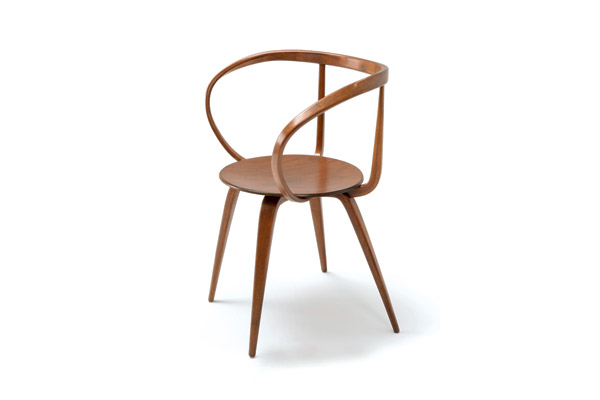Nicholas Ho visits the exhibition entitled “George Nelson: Architect, Writer, Designer, Teacher” and files this report.

April 22nd, 2014
Top Image: George Nelson. Photo © Vitra Design Museum Archive
George Nelson (1908-1986) is a celebrated pioneer of American modern industrial design in the 1950s, and one of the most influential designers to have shaped the world today. And from 17 March to 2 June 2014, an exhibition in tribute to the designer is being held at the Hong Kong Design Institute gallery

Exhibition’s opening ceremony in Hong Kong
Nelson’s expertise in the field of design extends from architecture to industrial design, and his belief that design isn’t mysterious was revolutionary among the general public at the time.

Exhibition’s opening ceremony in Hong Kong
The exhibition begins with a brief introduction to the master and showcases various models and pavilions to scale mock-ups for the viewer to experience Nelson’s evolutionary journey in the 20th century. Through studying his methodologies and witnessing numerous pieces of legendary furniture pieces, the show ties in Nelson’s architectural achievements at the end as a tribute to his contributions to the design world.

Two staff members in Nelson’s office with a model for the American National Exhibition “Jungle Gym”, Moscow, 1959. Photo © Vitra Design Museum Archive
In the 1950s, by reiterating his strong belief that design can shape the world, Nelson challenged traditional methodologies, from aesthetics to materials and craftsmanship. Through dissecting conservative designs, Nelson redefined the relationship between the user and the product, focusing on the function and structural integrity of a product, and how it can be improved to reflect the present era and cater to the habits of the user. From a working desk and chairs to prefabricated architecture, Nelson continuously tried to push for new boundaries. Certainly ahead of his time, his achievements became an endless source of inspiration for contemporary designers.

Pretzel Armchair. Photo © Vitra Design Museum Archive
His vanguard pavilion designs have changed the way exhibitions are curated for generations. Nelson redefined the dialogue between a viewer and the exhibits, enriching the experience by adding more depth and layers between exhibits to stimulate the viewing process. Such a technique is very popular in today’s practice.

Zoo Clocks, 1965. Photo © Vitra Design Museum Archive
Nelson’s architectural works, too, were truly ahead of his time. Being one of the first to experiment with prefabricated living pods, Nelson put forward innovative ideas suggesting a new way of life, offering both flexibility and cost efficiency. Without realising it, 40 years later, the practice of mobile living and prefabrication has proliferated and become a predominant way of living and working.
Although Nelson’s era was more than 30 years ago, today, our designers and producers are still communicating with the master as if he is still teaching us. It would be interesting to see an exhibition where contemporary designers create pieces to set up a present day dialogue with George Nelson’s works, to witness the evolution of human civilisation.
The exhibition “George Nelson: Architect, Writer, Designer, Teacher” has been developed by the Vitra Design Museum in Germany and is presented in Hong Kong by Herman Miller Asia Pacific. It is being held at the HKDI Gallery from 14 March to 2 June 2014. For more information, visit hkdi.edu.hk/hkdi_gallery
A searchable and comprehensive guide for specifying leading products and their suppliers
Keep up to date with the latest and greatest from our industry BFF's!

Suitable for applications ranging from schools and retail outlets to computer rooms and X-ray suites, Palettone comes in two varieties and a choice of more than fifty colours.

Channelling the enchanting ambience of the Caffè Greco in Rome, Budapest’s historic Gerbeaud, and Grossi Florentino in Melbourne, Ross Didier’s new collection evokes the designer’s affinity for café experience, while delivering refined seating for contemporary hospitality interiors.

Savage Design’s approach to understanding the relationship between design concepts and user experience, particularly with metalwork, transcends traditional boundaries, blending timeless craftsmanship with digital innovation to create enduring elegance in objects, furnishings, and door furniture.

Marylou Cafaro’s first trendjournal sparked a powerful, decades-long movement in joinery designs and finishes which eventually saw Australian design develop its independence and characteristic style. Now, polytec offers all-new insights into the future of Australian design.

Presenting Your Moment INDESIGN, an exciting creative campaign brought to you by Indesign Media and eight of Australia’s best known architects and designers. Experience the campaign and hear from these leaders of industry about the design philosophies they live and work by, and how INDESIGN fuels their daily practice.

Leading the crusade for sustainable architecture and design, Made In Earth Collective makes architecture in a geographical and cultural context that is closer to people with the ability to sustain ecosystems.

Vipoo has taken home the winning title in the biennale MAKE Award for Australian creatives. Learn who took home second prize and highly commended in what is Australia’s richest, non-acquisitive prize for craft and design in Australia.
The internet never sleeps! Here's the stuff you might have missed

We spoke with George Fleck, Vice President and Global Brand Leader of W Hotels, about the intermingling of hotel and hospitality design trends.

Esteemed international practice OMA has completed AIR in Singapore, a genre-straddling project defined by openness and an emphasis on waste.